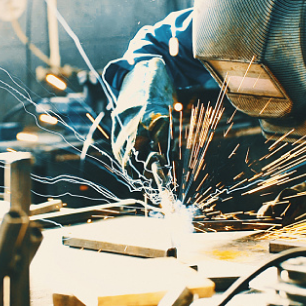Jump to:
Monitoring Resistance Welding for Production Success
Resistance welding can be tricky. Small changes in material, tooling, equipment performance, or process settings can disrupt operations and halt production. To ensure weld effectiveness, many manufacturers rely on destructive audits; however, real-time process monitoring tools, such as resistance weld monitors, provide insight into what’s happening during the process, detecting problems as they occur and enabling quick corrective action.
This article outlines key concepts in monitoring resistance welding and shares three real-world case studies that show the value of using weld monitors in production environments.
Defining Welding Success
Success is typically defined by outcomes like pull strength, conductivity, or hermeticity. These characteristics are usually confirmed through destructive testing. However, by monitoring input and output process values, manufacturers can predict weld success without scrapping parts.
Three core components affect weld success:
- Material: Alloy type, coatings, or surface conditions due to aging
- Equipment: Condition of the power supply, tooling, and fixturing
- Process: The settings used during welding
Repeated application can yield consistent results once these parameters are optimized and documented as a weld recipe. But when variation creeps in, continuous monitoring of output parameters enables nondestructive examination and detection of abnormalities.
Fundamentals of Resistance Welding
Resistance welding relies on electrical current and the resistive properties of metals to generate heat and form a bond. It’s influenced by electrical values (current, resistance, voltage) and mechanical factors (force, displacement).
Modern weld monitors — refined since their introduction in the 1970s — track these variables in real time, recording waveforms and generating visual plots that help pinpoint deviations.
Setting and Using Limits
To ensure effective monitoring, numerical values like current, voltage, force, and displacement are correlated with known good welds. During process qualification, a design of experiments study should be performed to identify which factors most affect quality. This also helps define acceptable ranges using statistical metrics (e.g., ±10%, or ±1σ, ±2σ, ±3σ) and capture known failure modes.
Limits can be applied to numeric values (e.g., minimum, maximum, or root mean square) as well as to the full waveform shape vs. time. In general, the full waveform comparison is preferred because it provides more information about the weld, and since the limits span the entire waveform, it can reveal potential issues that might be missed when looking only at numeric values. The advantage of simple numeric values is that the judgment can be passed significantly quicker. Higher-risk welds, such as those used in medical or aerospace devices, require stricter thresholds than those in low-risk products.
Once limits are set, production welds can be compared against them. Welds falling within bounds are assumed to be good; those falling outside are flagged for further action.
Case Study 1: Diagnosing Intermittent Cold Welds
A customer reported welds exhibiting occasional weakness. A monitor was attached to the machine, and numerical weld data was charted. One weld revealed a voltage spike above the process limits, which also correlated with a dip in current — Fig. 1.
Although the numeric data indicated an anomaly, it didn’t explain why. Waveform analysis revealed the current dropped to zero during part of the weld pulse, reducing effective weld time by about 20%. This corresponded with reports of cold welds.
Examining voltage waveforms across 30 welds showed all were stable except the one outlier, where the power supply maxed out trying to compensate for an open circuit. This ruled out part or equipment issues, pointing instead to an intermittent electrical connection.
This case demonstrates how waveform monitoring adds diagnostic depth beyond what numeric data alone can provide, allowing the identification of root causes in real time.
Case Study 2: Equipment Performance Instability
This example focused on the consistency of a direct current power supply’s current output — a key performance factor in resistance welding. Twelve consecutive weld pulses were overlaid, and waveform stacking showed noticeable variation once the minimum and maximum were isolated — Fig. 2.
When the highest and lowest current pulses were compared, an 8% difference was found. This is significant because welding heat is proportional to the square of the current. Even small differences can lead to major quality variations.
Although summary data may not reveal such fluctuations, waveform analysis clearly showed the issue, enabling corrective actions to improve weld consistency.
Case Study 3: Weld Process Troubleshooting
Sparking during welding indicates energy loss and poor weld quality. It can occur due to several factors, including material alloy, plating, and inadequate force.
In this case, a weld-through sensor was used to track both current (yellow) and force (green) waveforms — Fig. 3. The chart revealed that current was applied before force stabilized, about 40% below target, resulting in sparking and inconsistent welds.
The issue stemmed from a change in the weld head’s force-fired trigger settings. Instead of initiating the weld pulse based on force threshold, a 250-millisecond timer was used to speed up production. This caused the weld to start before sufficient force was applied. By reenabling the force-fired feature and resolving the cause for slow force generation, the system ensured the pulse would only begin after the target force was reached.
Once the trigger was corrected, sparking stopped and weld consistency returned. This case highlights the power of visualizing process parameters to identify and fix dynamic timing problems in real time.
Summary
Production issues in resistance welding are inevitable, but staying ahead of them is key to meeting production goals. These case studies show how weld monitors provide valuable insights and remove the guesswork from troubleshooting.
Optimize your resistance welding process with the following:
- Maintain consistent preparation. Clean materials, consistent setups, and trained operators are essential.
- Document the weld process. Capture and record material type, equipment condition, and process settings.
- Use a process monitor. Gain real-time visibility into the weld and detect issues before they impact production.
Whether auditing periodically or monitoring every weld, you can use the right tools to help maintain high weld quality and uncover root causes quickly when problems arise.
This article was written by Mark L. Boyle (director of product engineering and applications at Amada Weld Tech, Monrovia, Calif.) and Steve Shea (southern regional sales manager at Amada Weld Tech, Monrovia, Calif.) for the American Welding Society.


